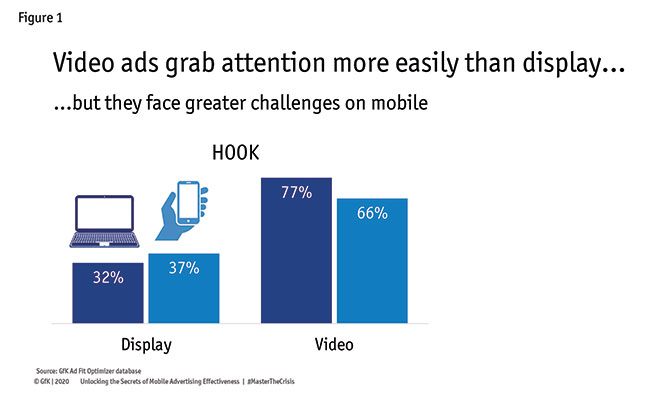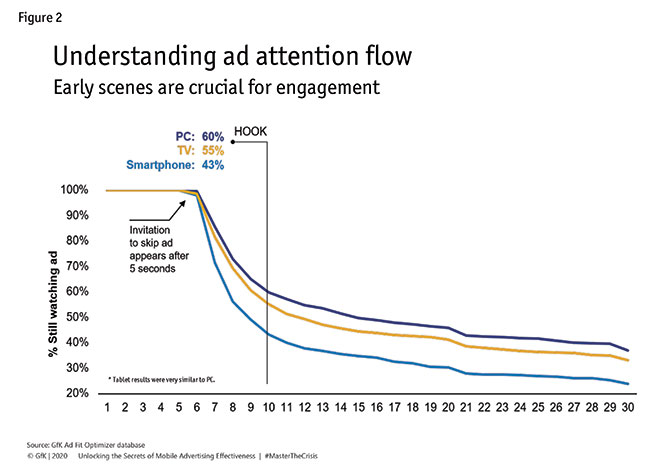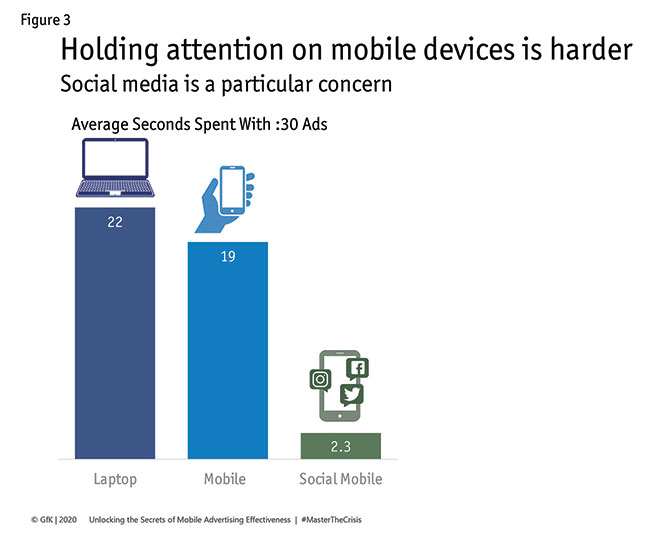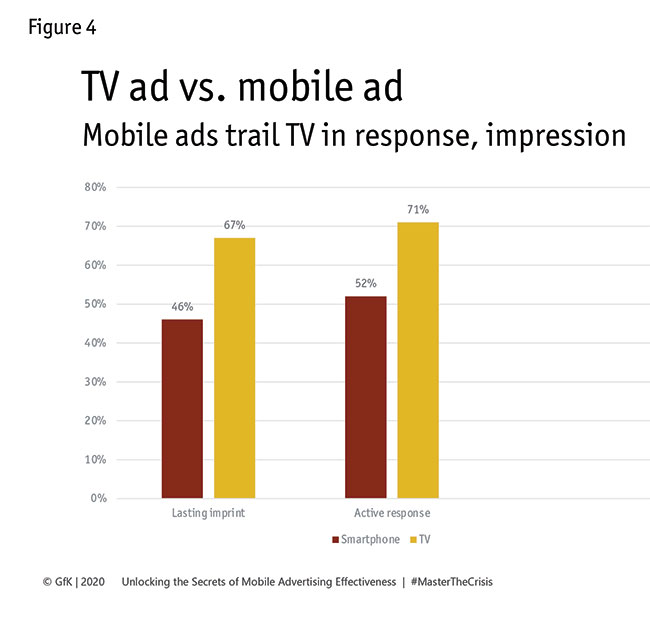Optimizing for effectiveness
Editor's note: Jon Brand is senior vice president in marketing effectiveness at research company GfK.
Even before the COVID-19 pandemic, mobile media were playing an increasingly powerful role in consumers’ lives – and, not surprisingly, in media budgets. In the U.S., mobile media now exceeds one-third of all media spending and a 2021 GfK study shows that, among common digital technologies, smartphones are most trusted and relied on by U.S. consumers.
Throughout the day, consumers return to those small(er) smartphone screens again and again – for an average of 63 interactions every day, according to Leftronic. No other technology or platform can claim this kind of repeated exposure and 24/7 influence.
But when it comes to advertising, smartphones – and mobile devices generally – are too often playing second fiddle to “traditional” technologies: TVs and PCs. There has been little effort to truly understand mobile ads in their own context and environment. Evaluative approaches are not as robust as traditional TV techniques – and systems are often inconsistent with past testing, leaving management confused on how to interpret.
The truth is that little is actually spent on digital ad testing in general; simplistic approaches with few diagnostics provide a minimum of information or inspiration to drive stronger creative. And when it comes to mobile ads, the commitment to evaluating and refining is even weaker. Despite the impressive growth in streaming over mobile devices, they simply are not given their due.
Create special demands
We know that consumers interact with mobile devices in unique and specific ways – vastly different from a TV or PC environment. Screen size has a huge effect on how people engage with and experience advertising; small pictures and uncertain sound quality create special demands on creative. Frequently, mobile media are viewed in the context of other activities – watching TV, working or even socializing. And people bring a different mind-set to smartphone time than they do to larger screens; it is less about kicking back and more about getting things done.
Making the right impression in a mobile context requires a special, dedicated focus on what works in this sometimes unforgiving environment. A standout campaign created for bigger screens may translate poorly to handheld devices. There are good reasons to say, in fact, that smartphones should be the primary platform advertisers use for evaluating their campaigns, as they provide a more challenging creative context for ads.
Brand managers, ad creators and media planners all need to put their mobile thinking hats on – not to think “smaller” in terms of ambition but rather to make the most of every platform on its own terms.
Problem only grows
We know that consumers are increasingly difficult to engage in any context. Two-thirds of people say they feel “bombarded” by advertising and just three out of every 100 ads make an impression on consumers. This problem only grows when it comes to mobile platforms, because people are less receptive to ads on smartphones and tablets, as compared to TVs. GfK has found that just 11% have a favorable view of mobile ads, compared to 49% for TV ads.
With all of these challenges, how can brands capture and keep the attention of smartphone and tablet users? The good news is that GfK’s Ad Fit Optimizer has shown that well-executed ads on smartphones can be as effective as on larger screens – though the standards for success must be a little more stringent. Like all ads, simple and visually stimulating ads are most effective at engaging consumers on small screens. Emotionally engaging consumers with content that is personally relevant is critical, whether the ad is a video or display, long or short.
Recent GfK research – focusing directly on how people react to ads in mobile environments – looks at two key aspects of effectiveness: hook (the ability to grab attention) and hold (the challenge of keeping consumers engaged). Ads that score high in both of these areas, when viewed in a mobile environment, stand the greatest chance of impacting people.
Homing in on ad exposure and use in mobile settings, our study has revealed a number of guidelines for successful campaigns – what will cut through the mobile clutter and speak to overwhelmed consumers.
1. Be bright and clear
On mobile devices, consumers are active scrollers, moving down a page quickly and skipping over content that does not capture their interest. Our study shows that consumers often scroll right past ads (video 25% and banner 42%), never paying any attention to them.
And even those ads that consumers do happen to look at are often quickly dismissed on smartphones, with only two-thirds still watching an ad after 10 seconds. In comparison, 77% of consumers are still engaged at that point on TVs and PCs.
Moreover, social media ads are increasingly being viewed on mobile devices, which creates additional hurdles in engaging consumers. In addition to screen size, ad length and scrolling, ads must also overcome the fact that all sound is typically muted on social media unless specifically activated by the viewer. This makes video ad visuals particularly critical for social platforms.

Display ads also play a key role in mobile media budgets. While they are not impacted by screen size as much as video ads, display creatives face their own fundamental challenges in connecting with consumers on small screens (hook is less than 40%), making it critical to focus efforts on how to attract consumer attention (Figure 1).
We also have found that bright and vibrant colors and engaging close-in visuals (rather than long-distance shots) help draw viewers into ads on smartphones. Moreover, initial scenes in video ads that intrigue consumers and/or pull them in emotionally are most effective (Figure 2). In contrast, ads that are more mysterious – not revealing their key messages till the end – and have darker visuals and fast-changing scenes often are less able to engage consumers.

Takeaway: Attention to ads on smartphones is even more fleeting than on larger screens but trading moody and mysterious for upbeat and inviting can do a lot to make up the difference.
2. Simplicity leads to staying power
Sustaining engagement with ads is usually much tougher than simply grabbing eyeballs. This is even more true for ads on smaller screens; while only (51%) of consumers watch the full video ad on a smartphone, the figure is nearly two-thirds (61%) for the larger screens. When it comes to banners, consumers spend very little time with them – roughly two seconds.
Younger individuals who grew up with smartphones have developed the most unique relationships with their phones and the content they view on them. They are the most likely to disengage from ads on their smartphones very quickly relative to how they respond to ads in other environments – so ads targeting young consumers need to be particularly sensitive to how to engage them.
In their own way, though, older consumers are also proving to be very hard to hang onto. While mobile ads rate below those on traditional screens for maintaining engagement across the board, the shortfall is particularly severe in the 60-plus age group. Like young consumers, Boomers are half as likely to stay with a mobile ad when compared to ads on a large-screen. This often relates to the ability to focus on the detail on the small screen.
Mobile ads on social media pose a particular engagement challenge for advertisers, with viewers spending just 2.3 seconds on average with ads served through a social platform (Figure 3). In comparison, non-social mobile video ads hold attention for 19 seconds and laptop ads for 22 seconds – dramatically longer. 
The hurdles facing video ad engagement have driven many marketers to move to shorter video ads, including six-second executions. These short-form video ads provide their own unique challenges to creative teams. It is essential that ads make an emotional connection with consumers and we find that this happens most efficiently when messages are simple and relatable. Our research shows that people are slightly more likely to feel affection in response to smartphone ads – so the opportunity for intimacy and engagement is real.
Takeaway: To maximize “hold” with small-screen advertising, focus on younger cohorts and stay away from complicated content and messages.
3. Larger is often better
The smaller screen size makes things that appear clear and inviting on larger screens seem distant and hard to read. Logos and other branding elements are a particular concern, hindering linkage back to the brand. Similarly, visuals that are long views can become less engaging to the viewer who feels less a part of the action. Doing visual checks of how ads look on small screens can help overcome these issues.
Takeaway: On smaller screens, there is an even greater need to “think big” – especially when it comes to branding elements.
4. Play the long game
With attention spans being shorter on mobile devices, it is not surprising that mobile ads are less likely to leave a lasting positive impression and trigger a response than those seen on TV (Figure 4). Keeping ads engaging and messages simple will help mobile advertising have more of a lasting impact.
Takeaway: Focusing on an ad’s ability to engage and communicate will help overcome the challenges of working in a mobile environment.

5. Test in realistic settings
It may seem obvious, but to understand what works on mobile devices, it is essential to test ad creative on those technologies, in situations that replicate actual exposure. The dramatic performance differences between traditional screens and smaller, mobile ones show that setting is (almost) everything. Does your testing replicate the multitasking, highly fragmented world that smartphones inhabit? Can you get a clear sense of how your creative and messaging will come through in a mobile environment? There may be a great deal of money and effort riding on these questions, so getting the right answers is a must.
Takeaway: To be sure mobile is served by your campaign, take a mobile-centric approach to your research as well.
Respect and concern
As smartphones continue to claim a growing piece of the ad pie, brands and agencies need to treat this always/everywhere platform with high respect and concern. The effectiveness of campaigns will increasingly hinge on mobile performance and making sure that creative anticipates this environment is essential.
How strong is your mobile ad game?
